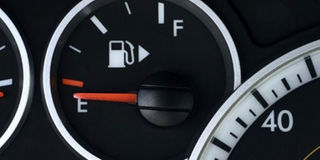When the fuel gauge reads empty, how far can you go?

What you need to know:
- Most manufacturers by and large have generous reserve tanks. There is no standard for how big the fuel tank reserve is, but the percentage oscillates between 10 and 15 per cent of the size of the tank.
- This, according to Moses Kakembo, a manager at a fuel station in Najjanakumbi, helps you to have a proper estimate of the size of your reserve tank.
Well, most drivers have been victims of an empty fuel tank. Some are just not aware while others cannot avoid it.
As you drive to your destination the fuel gauge starts to read “E” before a blipping sound on an illuminate light reminds you of the impeding danger.
Many drivers have been here and their only option is to drive on to the next petrol station, which is a distance away.
However, how far can you drive on an “Empty” dashboard sign before the car can totally run out of fuel?
The distance will depend on a number of variables, key among them the age and model of the car as well as weight of the items in the car.
However, the interest should focus on the low fuel warning light or a blipping sound, which emphasise the need to refuel before the car comes to a complete halt.
Have a functional gauge
Many people drive cars with no functional fuel gauges. They just make estimates on the amount of fuel they need to drive to a certain destination.
This is quite risky and is an example of irresponsible driving that borders on unprofessionalism.
According to Ivan Kyeyune, a mechanic on Rubaga Road, it is common for drivers to drive around without caring to know how far the fuel in their tank can drive them. “This is an indication of an unprofessional driver. And if you are seated in a car manned by such a person you need to just be careful,” he says.
A car’s fuel consumption schedule is designed in such a way that it is able to alert you at all stages in case the fuel drops to a certain level.
It will alert you when it filled to the brim, half way and when it is empty. However, beyond empty it again illuminates a red light or a blipping sound before it comes to a halt.
However, many drivers ignore or have disabled this warning mechanisms and are never alerted before the car completely runs out of fuel.
Currently, newer cars are fitted with technology that will give you a conservative estimate of how many kilometres you can cover with the amount of fuel in your tank.
Of course this estimate depends on certain variables that might include the demands of your engine or the weight of your car.
Do not be caught unaware
Ensure that you have enough fuel in your car or your gauge is reading right to avoid surprises.
The amount of fuel left in the tank when the low-fuel warning light illuminates varies greatly from car to car even within a particular model line.
You will find that some cars can drive for a sizeable distance when the car starts reading empty while others will barely drive beyond a kilometre before then come to a halt.
For instance, most small cars will ably drive a sizable distance even when they are reading Empty.
However, as a driver you must be able to note that the fuel gauge is not the most precise instrument. It has inherent mechanical inefficiencies and some obstructions that can potentially mislead a driver.
Reserve tanks
Most manufacturers by and large have generous reserve tanks. There is no standard for how big the fuel tank reserve is, but the percentage oscillates between 10 and 15 per cent of the size of the tank.
This, according to Moses Kakembo, a manager at a fuel station in Najjanakumbi, helps you to have a proper estimate of the size of your reserve tank.
“Get to know your car. Small things such as the size of your car’s reserve tank are signs of a driver who cares and understands their car,” he says.
Most cars, depending on the size of their reserve tank, will drive between 40 kilometres and 70 kilometres after the gauge has dropped into the Empty zone.
That of course will depend on the style of driving and the weight of the car.
However, after the light has illuminated it is important that you refuel or employ conservative fuel saving driving tips such as avoiding unnecessary acceralation or aggressive braking.
Manual Vs automatic transmission vehicles
Unlike manual cars that are likely to cover some distance, even after the fuel has completely run down, automatic transmission cars will come to a complete halt once the fuel tank dries up.
However, even then (manual cars that cover some distance after the have run out of fuel) becomes a menace road because their speed becomes intermittent.
So while it’s okay to take experiment, it is risky especially after the car’s fuel gauge has fallen to Empty zone.



